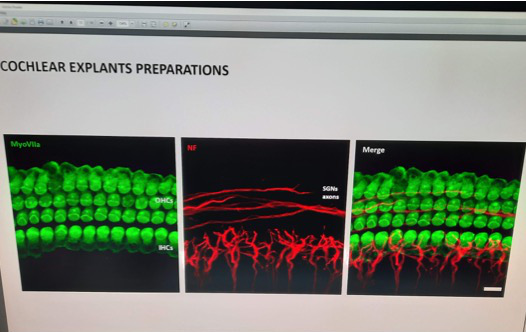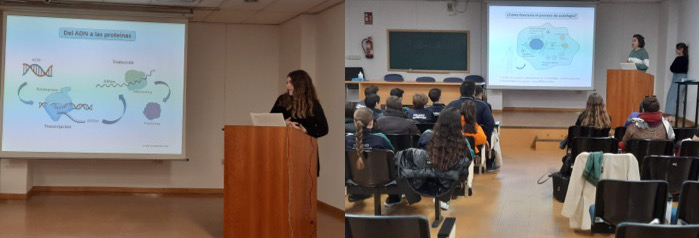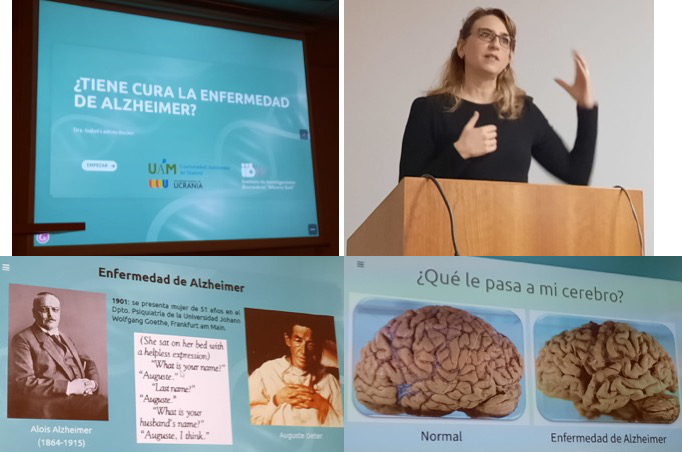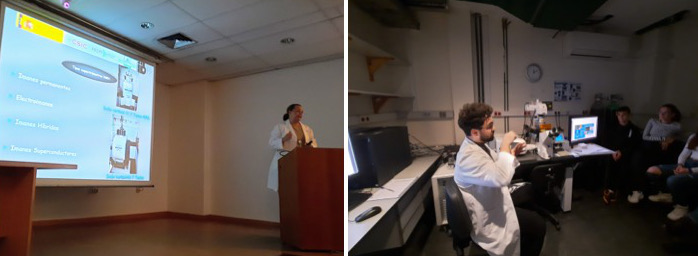Numerous researchers, including scientific and technical staff, from the Instituto de Investigaciones Biomédicas Alberto Sols, IIBM (CSIC-UAM) have participated in this year's edition of the Science and Technology Week at the CSIC (SCT2022).
The activities offered between November 8 and 21 consisted of: two scientific routes, two experimental workshops and four conferences. All the initiatives were fully booked and many schools were on the waiting list.
As every year, in November the doors of the Research Centers in our country open to commemorate the Science and Technology Week. The CSIC encourages its Institutes to organize outreach activities for the general public in order to promote society's interest in science and to help them achieve a greater scientific culture. A society educated in scientific culture will be more easily able to face the challenges arising from social and environmental changes. Special attention should be paid to the young; it is important to stimulate scientific vocations, because they will be the scientists of the future.
At the IIBM, SCT2022 has been held with great success, both on the part of the Center's staff and participants, most of whom were high school students. The research community and technical staff of our Center has been, without a doubt, especially motivated and as a consequence eight different activities have been organized, one of them, the workshop coordinated by Ricardo Escalante, "The Dycti amoeba helps us to investigate rare diseases" has been carried out in three consecutive days. The conference given by Isabel Lastres-Becker, "Does Alzheimer's disease have a cure? managed to attract the attention of a large number of people, both groups of vocational training students and adults, who requested their attendance individually.
We will summarize all the activities carried out by IIBM scientists.
- On November 8 we inaugurated SCT2022 with the workshop "Cancer Influencers: how to catch it infraganti" given by Ana Monfort Vengut and María González Álvarez. This scientific workshop was not held in the best conditions, because the meeting room was used as an improvised laboratory. Nevertheless, these two young researchers attracted the students with a brief explanation about cancer cells, where they included the game "Trivial Time", which was both fun and educational. This was followed by an experiment and a visit to the Cell Cycle & Cancer Biomarkers Group laboratory to observe normal and cancerous cells under the microscope. Twenty students from the Higher Degree of Health Documentation and Administration were privileged to attend this workshop.

-
The Scientific Route "Researchers for a day in hearing and hearing loss" was coordinated by Silvia Murillo-Cuesta from the Non Invasive Neurofunctional Evaluation Service (ENNI). Numerous researchers participated: Sandra Franco-Caspueñas, Ángela García Mato and Elena Torres Campos from the Hearing and Myelinopathies Laboratory and Mónica Martín Belinchón from the Microscopy/Confocal Service. This route began in the auditorium of the IIBM and had several stops at the ENNI and at Microscopy. We learned many things about the inner ear, its neurosensory cells, why there are still no drugs to alleviate hearing loss, etc. Later, Sandra Franco-Caspueñas showed us what cochlear implants are like. Twenty-six students from the Adult Education Center, Aluche , and the Higher Professional School of Madrid took this route.

-
Ángela Martínez-Valverde, Patricia Rada and Vítor Ferreira da Silva from the Physiopathology and molecular mechanisms of obesity and associated co-morbidities laboratory gave a presentation entitled: "The exciting day to day researching obesity and its complications: the different stages of the research career" for 53 students of 3rd ESO of the Sagrado Corazón school, as well as for other people who came individually. The presentation explained the everyday life in the laboratory from the perspective of a predoctoral researcher, postdoctoral researcher and laboratory manager.

-
The scientific workshop: "The Dicty amoeba helps us to study rare diseases" was held on November 16, 17 and 18. In addition to the coordinator of the activity, Ricardo Escalante, five researchers participated with great passion to communicate and disseminate their knowledge: Alba Tornero, Laura Collado, Laura Antón, Miranda Bueno and Celia Cruz. Each day we were visited by a different educational center: Colegio Zurbarán de Colmenar Viejo (26 students from 4th ESO), Colegio Decroly (25 students from 4th ESO) and Colegio San Agustín los Negrales (25 students from 1st High School). The workshop was planned so that in the laboratory of "Functional Genomics in Dictyostelium: Autophagy and Mitochondrial Dysfunction" there were between 10 and 12 students, where the Dictys were observed under the binocular loupe and the microscope, among other activities. The rest remained in the lecture hall "playing" at transcribing and translating DNA sequences to identify a "normal" and a mutated protein involved in autophagia process. The workshop included a guided tour of our Institute, which was a great fun for the students, as they were surprised to discover several interesting devices.

-
The conference "Is there a cure for Alzheimer's disease?" was given by Isabel Lastres-Becker from the "Parkinson's, ALS and tauopathies laboratory" on November 16 at 6:00 pm. This activity was attended by about 90 people. Two groups of students visited us (40 students from the Technical Course in Nursing Auxiliary Care of the María Inmaculada Center and 25 students from the Official Professional Training Institute CEAC and another 25 people who came on their own).

-
Two IIBM researchers participated in SCT2022 with activities carried out outside the IIBM. Gemma Ferrer Mayorga (Laboratory of Alberto Muñoz Terol) gave a seminar entitled: "Vitamin D, a tool to prevent cancer?" at the Trinity College of San Sebastian de los Reyes, for 65 students and Águeda González Rodríguez (Physiopathology and molecular mechanisms of obesity and associated co-morbidities) carried out an activity that included a lecture and a workshop in the histology and cell culture laboratory of the Research Unit of the University Hospital Santa Cristina, entitled: "Translational research: direct line between the laboratory and the patient". Two educational centers attended this initiative, Colegio Santa María del Camino and Colegio Decroly.
-
The last activity of the SCT2022 at the IIBM was the scientific route: "Bioimaging techniques in biomedical research", whose coordinator was Teresa Navarro from the Sebastián Cerdán Biomedical MRI Service, with the participation of Mónica Martín Belinchón, Vitor da Silva Ferreira, Nuria Arias Ramos and Pilar López Larrubia (the latter from the Biomedical Magnetic Resonance Laboratory). Two schools visited us on November 21, the Calasanz School of Pinto (29 students) and the Liceo San Pablo School of Leganés (20 students). This activity consisted of four parts: a lecture on the applications of magnetic resonance in research, in the auditorium, a visit to the Magnetic Resonance Service, then to the Optical/Confocal Microscopy Service and finally to a laboratory where these techniques are applied. The students stayed at our Center for 4 hours.

All the students received gifts provided by the Unidad de Cultura Científica y Ciencia Ciudadana (CSIC ). All the students seemed extremely happy about what they learned and the experience lived in our Center. Unfortunately, more than 30 Educational Centers requested a place in one of our activities, which we would have loved to accommodate, but our laboratories and our Technical-Scientific Services do not have the capacity to accommodate so many students. In addition, in most cases, it was not possible to repeat the activity. We hope that in the coming year more IIBM staff and groups will join us to enjoy communicating science to society. It really is a tremendously rewarding experience.
From the IIBM we would like to thank all the IIBM participants in this adventure during these two weeks of November, and to give them our CONGRATULATIONS for the passion, enthusiasm and illusion they have shown in the preparation of each activity, as reflected in some of the images presented in this text.